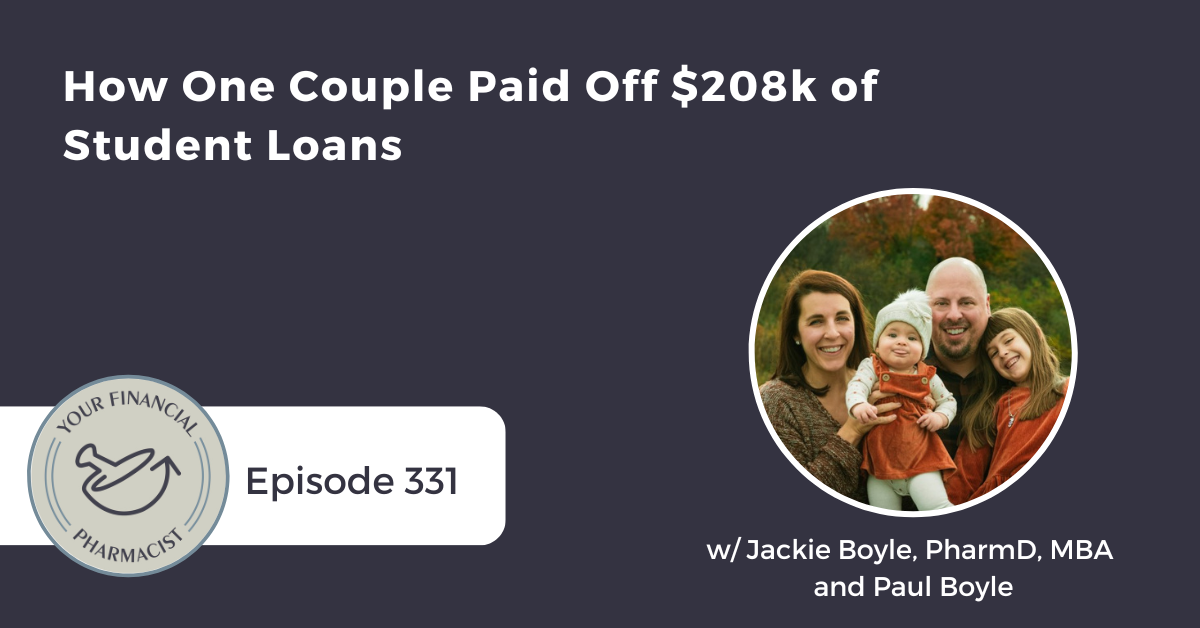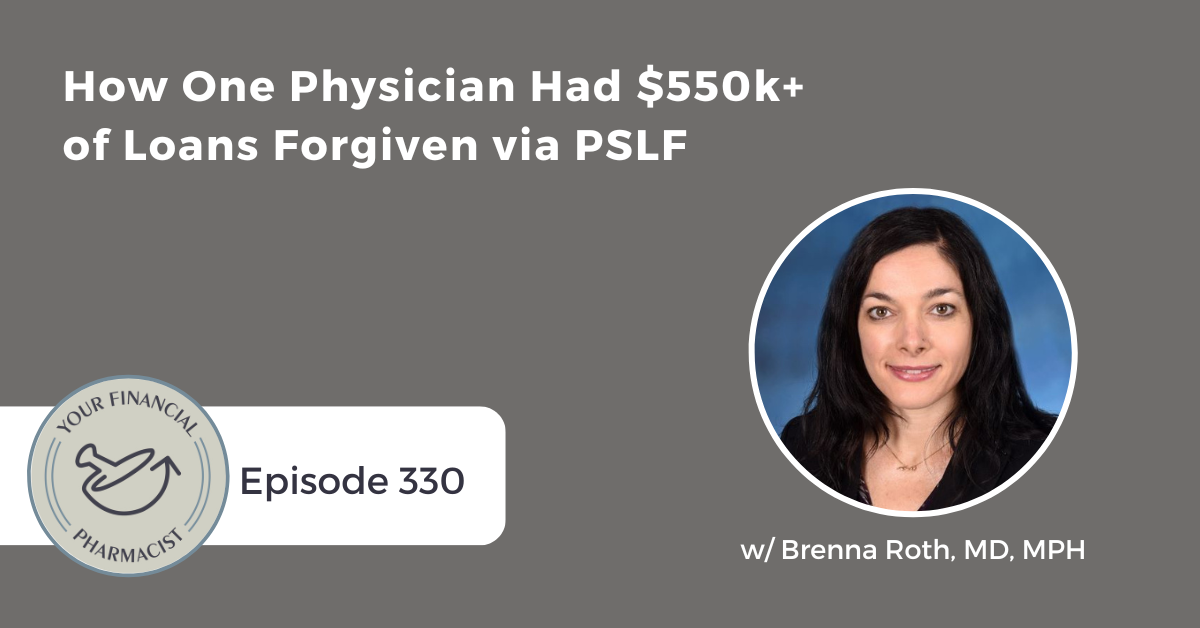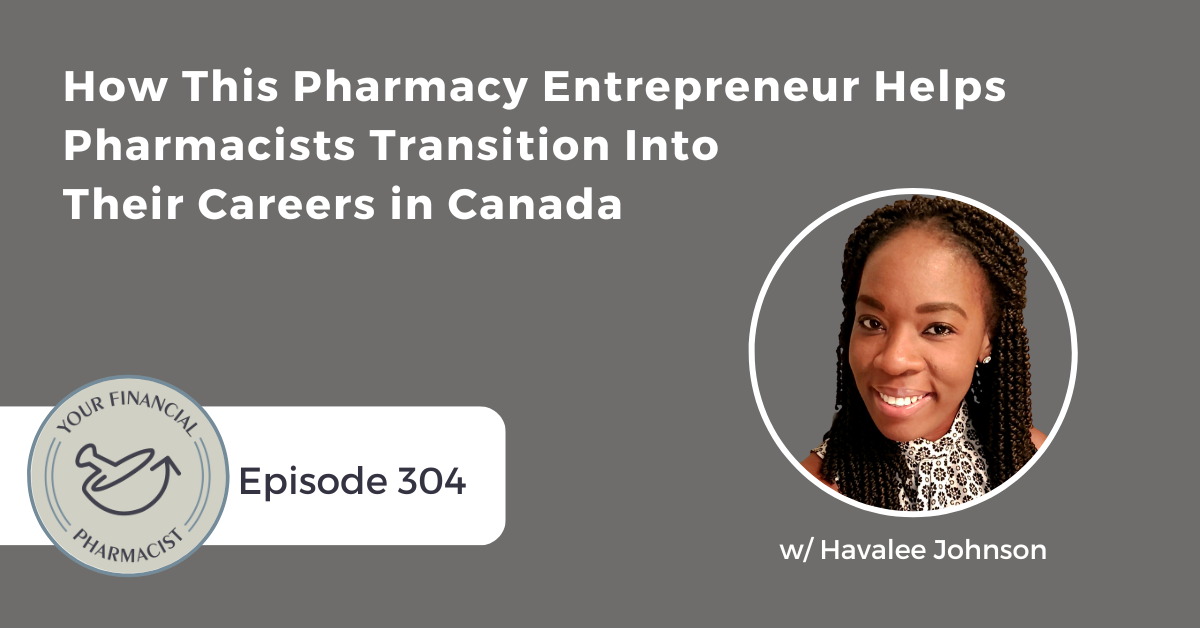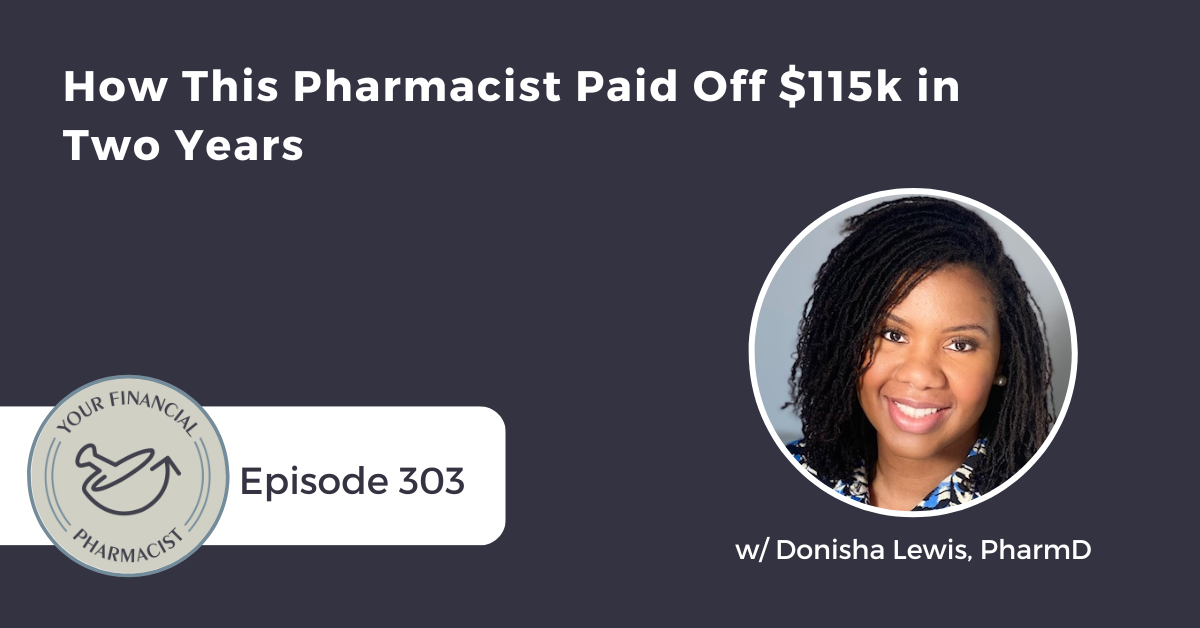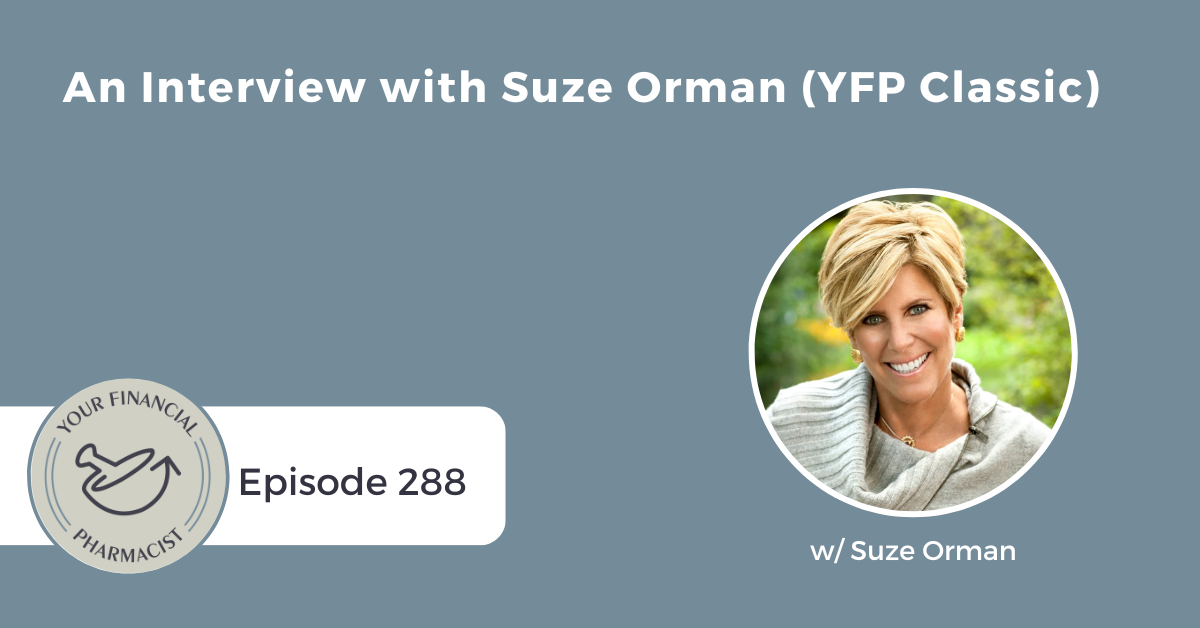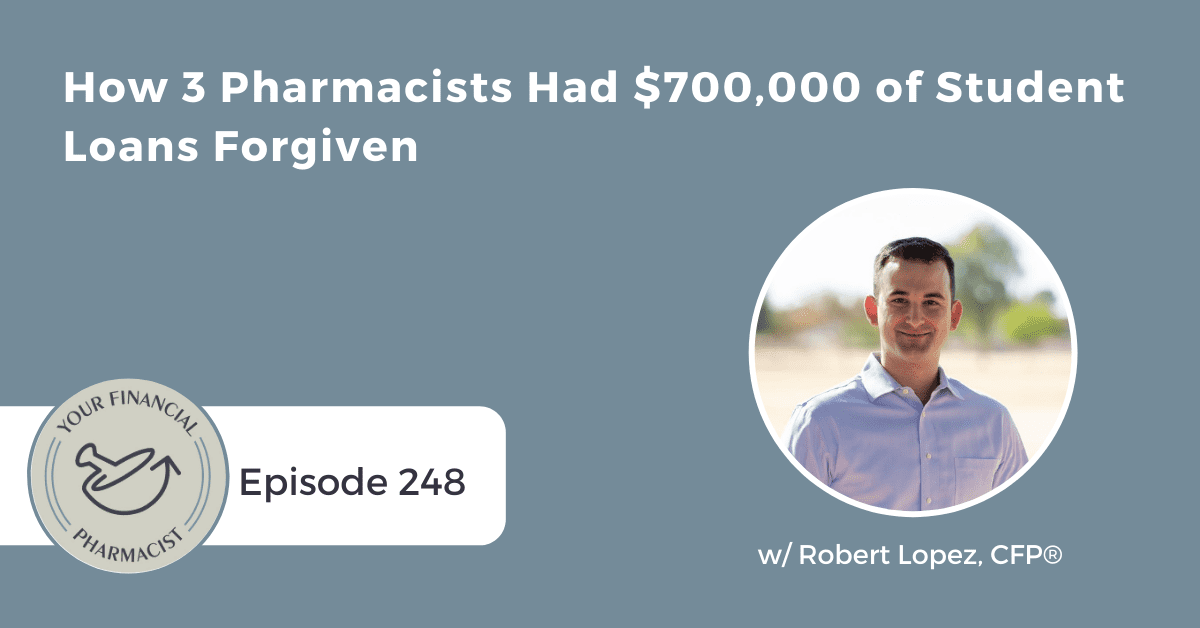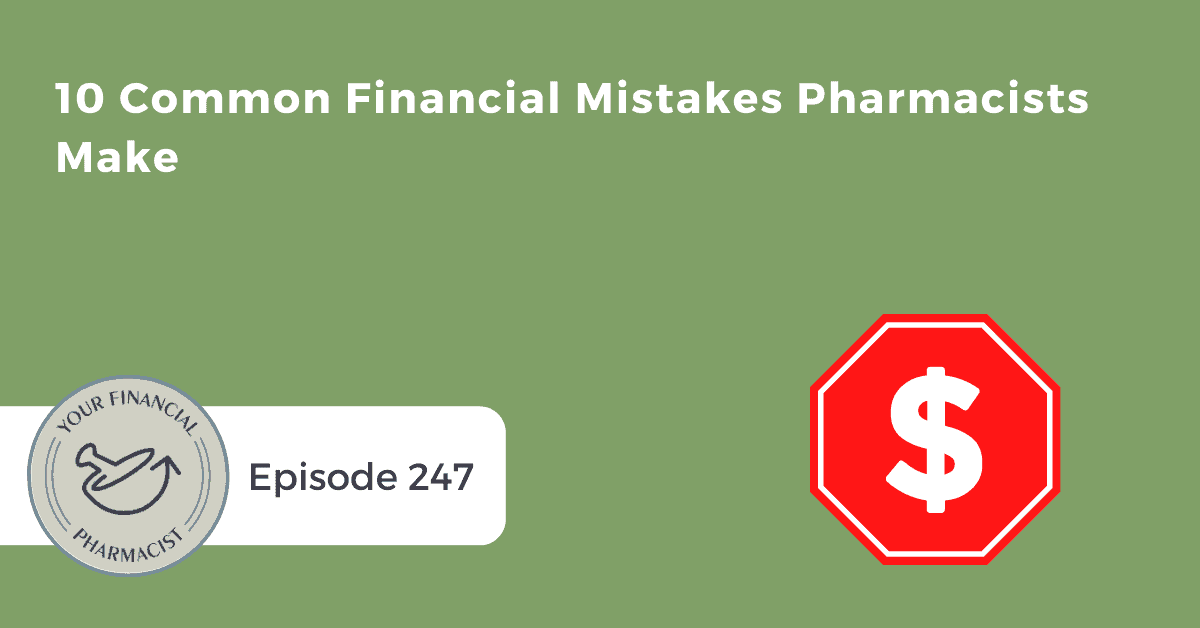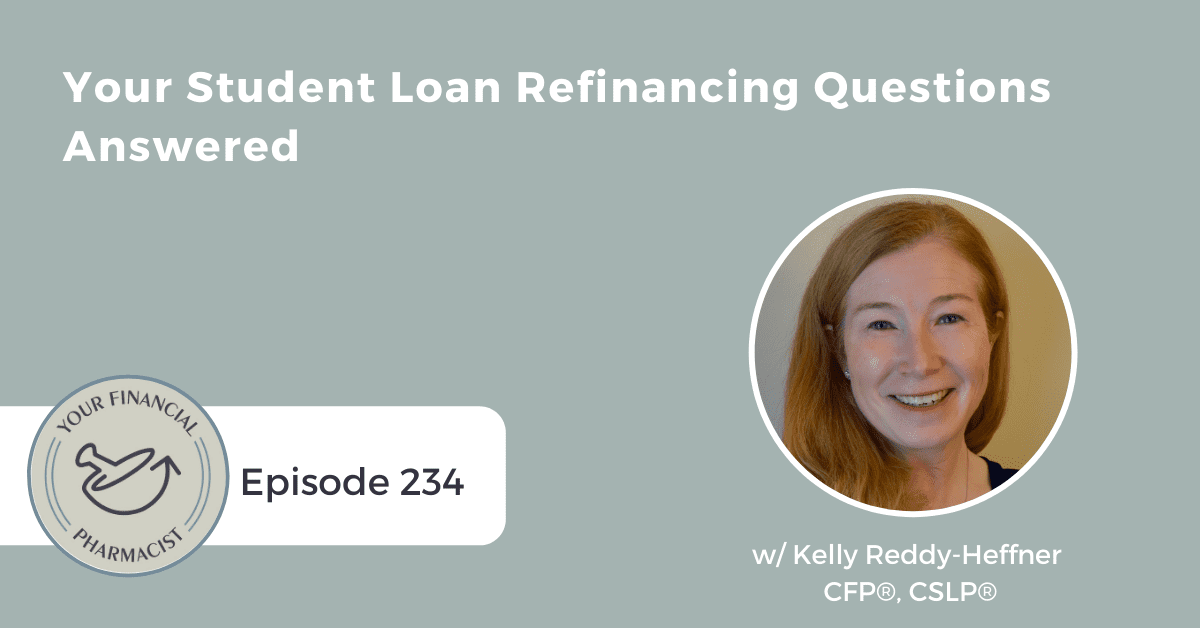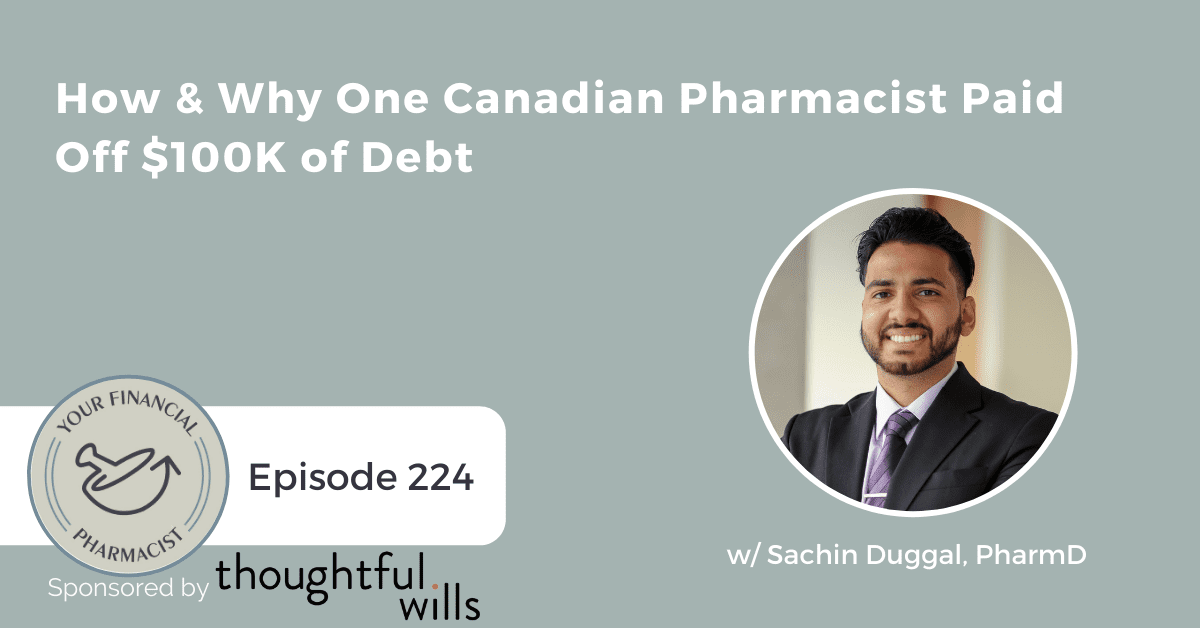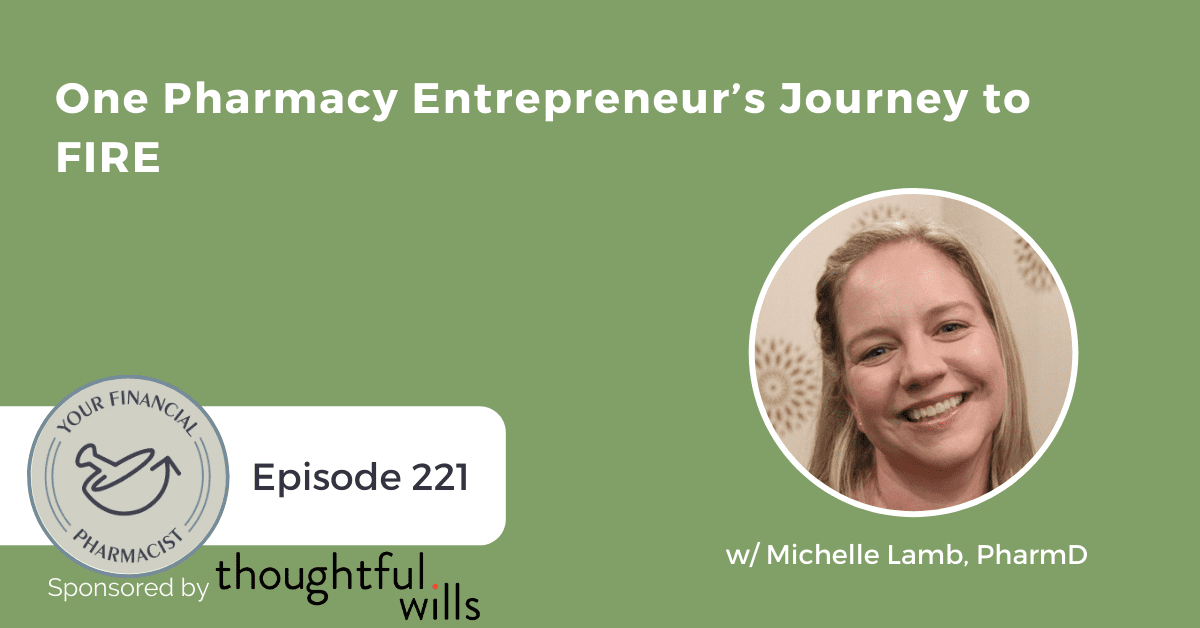On this episode, Jackie Boyle, PharmD, MBA and Paul Boyle share their journey paying off $208k of student loans.
Episode Summary
Debt can be an overwhelming weight on one’s shoulders, but imagine paying off an astounding $208,000 of it! This week on the podcast, we are joined by the inspirational duo, Jackie and Paul Boyle. They recount their journey from being neck-deep in student loans to paying them off entirely. This episode delves into their personal and collective strategies, their highs and lows, the financial compromises made, and how they kept the momentum to reach the finish line. From Paul’s decision to be a stay-at-home dad to Jackie’s reflections on missed opportunities with the PSLF program, their experiences provide invaluable insights for anyone navigating their own debt repayment process. We also dive into the emotional and financial challenges they encountered, especially when transitioning to a single-income household. Yet, their story isn’t just about the hurdles; it’s brimming with actionable takeaways and advice for those on similar paths. As Paul and Jackie demonstrate, with determination, strategic financial planning, and mutual support, even the heftiest of student loans can be overcome. So whether you’re struggling with student loans, seeking motivation, or just curious about the Boyles’ debt-free journey, this episode is a must-listen. Join us and discover how you too can rewrite your financial story!
About Today’s Guest
Jackie Boyle is a pharmacy educator by day and coaches pharmacists and pharmacies in a part-time capacity. She received her Doctor of Pharmacy from Northeast Ohio Medical University in 2012, MBA from University of Findlay in 2016, and Master and Bachelor degrees from THE Ohio State University (O-H!) She is highly involved in professional organizations including ASHP and AACP, and also loves spending time with her husband and two daughters, Gianna and Giulia. In her free time, she loves spinning, yoga, and enjoying a warm cup of coffee.
Paul Boyle is a Client Service Associate out of the Cleveland, Ohio area where he has had a diverse career of over 20 years, mostly taking care of customers and clients in various fields of service ranging from manufacturing to professional baseball. He received a Bachelor’s degree in Sport Management from The University of Akron in 2020, while taking time away from the workforce to raise his children. Paul spends most of his free time with his wife, Jackie, and two daughters, Gianna and Giulia. An avid Cleveland sports fan, musician and aspiring podcaster. When not supporting his local teams he likes to enjoy the occasional motorcycle ride, which is another longtime passion.
Key Points From the Episode
- Get to know Jackie and Paul, and their student loan debt repayment journey.
- The shared decision for Paul to be a stay-at-home dad and finish his degree.
- A reminder that you can make mistakes and still achieve your debt repayment goals.
- The extensive student loan debt that Paul inherited when he married Jackie.
- Having a baby and becoming a single-income household.
- How the emotional weight of student loans shifted throughout their debt journey.
- Why Paul always maintained confidence in their plan and abilities.
- Jackie’s income-based debt repayment strategy during her residency.
- Her biggest regret: not using the PSLF program.
- The challenge of staying motivated during an aggressive repayment journey.
- How Jackie and Paul maintained momentum.
- The value of budgeting and breaking repayment down into smaller goals.
- Why everyone’s debt repayment journey is different.
- Finding the right balance between debt repayment and investing in the future.
- How to assess your priorities and allocate your finances.
- Using your side hustle to pay for additional expenses.
- Refinancing your student loans and taking advantage of lower interest rates.
- Advice for new graduates as interest on student loans returns after the pandemic freeze.
- What’s next for Jackie and Paul now that they have their student loans behind them.
Episode Highlights
“We ended up paying off earlier than I anticipated due to some choices we’ve made. So, yes, it’s very exciting to be on this journey. That said, I know we definitely made mistakes as well.” — Jackie Boyle [0:05:27]
“I never thought inheriting this much debt comes with the territory of a relationship. So that was all brand new.” — Paul Boyle [0:07:57]
“I was so engulfed in residency life that, honestly, [repaying my debt] took a back burner. I should have been doing things way differently during that time.” — Jackie Boyle [0:09:30]
“If you look at that big number, you could be paralyzed by it. But if you look at those smaller numbers, it’s like, ‘okay, over the course of the next three months, I can achieve this goal, and I know how I’m going to achieve it.’” — Jackie Boyle [0:12:49]
“We never felt strapped or that we had to eat ramen for the next couple [of] years to achieve this. That made things better, and that’s motivating in its own [right]. You could see, ‘Hey, we’re doing great.’ We could keep this up as we’re going.” — Paul Boyle [0:15:52]
“Educate yourself. Find a mentor or a financial planner to work with. Get a budget in line. Those basic tools can be really helpful in giving you the motivation to realize that you can do this with a better understanding of your own personal situation and what’s possible.” — Jackie Boyle [0:26:26]
Links Mentioned in Today’s Episode
- Jackie Boyle on LinkedIn
- Paul Boyle on LinkedIn
- YFP Planning: Fee-Only Financial Planning for Pharmacist
- Subscribe to the YFP Money Matters Newsletter
Episode Transcript
[INTRODUCTION]
[00:00:00] TU: Hey, everybody. Tim Ulbrich here, and thank you for listening to the YFP Podcast, where each week we strive to inspire and encourage you on your path towards achieving financial freedom.
This week, I welcome Jackie and Paul Boyle as they share their journey of paying off $208,000 of student loans. We discussed the motivations behind their debt-free journey, how they balanced debt repayment with other financial goals, including investing and buying a home, lessons they learned along the way, strategies they employed to get on the same page, and advice that they have for those that are navigating loan repayment.
Okay, let’s hear a brief message from YFP team member, Justin Woods, and then we’ll hit play on Jackie and Paul Boyle’s debt-free story.
[00:00:40] JW: Hey, Your Financial Pharmacist community. This is Justin Woods here, Director of Business Development at YFP. You may be one of the 13,000 pharmacists that have already signed up for YFP Money Matters, which is our weekly newsletter. But if you’re not, what are you waiting for? I want to invite you to subscribe. We send financial tips, recommendations, the latest podcast episode and money resources, all specifically for pharmacists. It all comes straight to your inbox every Friday morning. So visit yourfinancialpharmacist.com/newsletter, or click the link in the show notes to subscribe today. Again, that’s yourfinancialpharmacist.com/newsletter. See you there.
[INTERVIEW]
[00:01:25] TU: Jackie and Paul, welcome to the show.
[00:01:27] JB: Hello.
[00:01:28] PB: Hey, Tim.
[00:01:29] TU: Well, this is a real treat for me. Many of your listeners may not know. Paul, you are a member of the YFP team, and so we’ve had the opportunity to work with one another here over the last several months. We’re incredibly grateful to have you as a part of the team.
Jackie, you and I have known each other. It’s got to be well over a decade, I think, at this point. I used to be on faculty at NEOMED way back when, and you started there as a student and then a resident. Then we were colleagues. You’re continuing to do great work there, and we’ll talk more about that here in a moment.
So this is a treat to be able to have both of you on as friends, as well as to share with our community your debt-free story. So congratulations to both of you and excited to dig into a little bit of what went behind that, how much debt you paid off, what were the motivations, what worked, what didn’t work, and what lies ahead for you guys now that you’ve got this big milestone achieved.
Paul, let’s start with you. Tell us a little bit more about your background, your career, and the work that you’re doing now.
[00:02:26] PB: Yes. So like you mentioned, I am part of the YFP team now as a client service associate. Love my job. Love the people I work with. It’s great to be a part of this community. But before that, my last paid job was with a company called Lincoln Electric, and I was a warranty service rep there in my last position. So still kind of helping customers out in that realm. But I chose to – well, we as a family made a decision when we had our first daughter that we wanted one of us to stay at home.
So me being the lesser income earner and with this topic, it’s student debt, we decided that my wife was going to continue to work and that I was going to be a stay-at-home dad. I used that time to go back to school, finish my degree in sports management and, yes, never looked back. Since then enjoyed the time with my kids. Being a stay-at-home dad was probably the best job that I’ve ever had so.
[00:03:23] TU: That’s awesome. Jackie, I just scratched the surface on my mention of your training at NEOMED and your residency and your faculty role. But tell us more about your pharmacy journey. What led you into the profession, including the work that you’re doing now?
[00:03:36] JB: Oh, thank you, Tim. This is such an exciting thing to be on your podcast, Tim. My relationship has gone on for so many years and so many different capacities. So I’m just so excited to be talking with you here today. My background is a bit of a mix of ambulatory care practice and education. So I started out my career in practice-based faculty roles and a few different settings in ambulatory care and then actually took a full-time position at the college at Northeast Ohio Medical University here in 2019. So I’ve been here for the past four years.
Around 2017, though, I started getting a little bit of an entrepreneurial itch. Of course, as Tim is one of my greatest mentors, I started talking with him about ideas for part-time work and actually got connected to an awesome entrepreneur, Alex Barker, who was starting a career coaching company at the time and have been career and business coaching pharmacists now for about six years, which plays into our story as well. It’s just been a ton of fun.
So, yes, a little bit of a few different things. I love being a jack of all trades and kind of exploring what’s out there in pharmacy. So, yes, this journey has been a long one, but I hope that we could share some of our mistakes, some of our wins, maybe inspire a few people along the way.
[00:04:59] TU: So, Jackie, let’s start with the juicy details around the student loans. How much did you end up paying off between the two of you when it was all said and done?
[00:05:09] JB: Yes. I think it was about $208,000. As the CFO of our family, I was keenly keeping an eye on our balances as they went down over time. It’s awesome to think back now how much we started with and where we ended up. We ended up paying off earlier than I anticipated due to some choices we’ve made. So, yes, it’s very exciting to be on this journey. That said, I know we definitely made mistakes as well, and I wish – for example, like PSLF. I probably could have taken advantage of that, but I didn’t even know that was a thing. So I’m here to say that you can make mistakes and still achieve the goal eventually as well.
[00:05:53] TU: Yes. That’s such a good reminder, Jackie. I think there’s so much pressure around this decision. We have the opportunity to talk with pharmacy students, new grads on a regular basis. We talk about the importance of really understanding these loan repayment options and getting that decision that’s best for your personal situation. I think that can feel weighty at times, right? Because it can have big implications, whether it’s a PSLF strategy or another strategy.
But, also, what you shared, I think, is such an important reminder is that mistakes are inevitable part of the financial plan. It’s going to happen. They happen on the regular and giving ourselves some grace and learning from those mistakes. We’re not always going to get it according to the textbook, and that’s okay, right? That’s part of this journey is to learn as well.
Paul, I want to start with you but really a question for both of you. As you think about your journey and the student loans, did your feelings around the student loans change over time? Some people we talk with, when I say give me the 0 to 10 student loan pain scale, where zero is the – no. They are what they are. They’re going to take care of themselves. Ten is the house is on fire, right? No right or wrong answer, but everyone is different on that journey. I’m just curious. Like for you, did that change at all along your journey, right? As you guys grew in terms of a family and your careers, tell us more about the emotions and feelings around the student loan debt.
[00:07:21] PB: Yes, absolutely. It’s intimidating for me at the beginning because when Jackie and I met, she had just graduated. So she went into residency. As everybody knows out there, residency pay is not quite the same as full pharmacist pay. But I was working full-time at the time, too. But just realizing like the massive amount of that compared to mine, I think what Jackie – I don’t know how much mine was at the time. I only had a couple thousand left to pay off on mine, and we paid it off first.
But kind of we got engaged, and I was like okay. I never thought like inheriting this much debt like comes with the territory of a relationship. So that was all kind of brand new.
[00:08:04] JB: I came with a lot of baggage.
[00:08:06] PB: Yes. It’s not bad baggage, but it’s just something that you never thought you had to plan for, right? So before even like our wedding and taking on a mortgage and stuff like that, here’s this amount of debt that amounts to a house. I think I took it pretty seriously, but I don’t think I felt like it was a pain point quite yet because, again, we were both working full-time. We figured, okay, we could come up with a plan to handle this.
But as it progressed and as I left work and we became a single-income household, it kind of went up there to like a seven or an eight maybe, just because of that weight like of all that debt, and like will we get there, and then we started a family and added expenses and stuff. So I wouldn’t say I lost sleep over it because I had kind of confidence in especially Jackie as our CFO and her earning potential that we could kind of navigate it.
[00:09:03] JB: Yes. I think, for me, I was in denial for the first two years. So during residency, I did income-based repayment, which meant that my monthly payments were zero. But the interest was accumulating rapidly, as you all know. So those first two years, I should have been at a seven or eight. But I was at like a zero to one because I’m like, “Oh, this is not – it’s not a problem right now. I don’t need to be paying attention to it.” I was so engulfed in residency life that, honestly, it took a back burner. I should have been doing things way differently during that time.
Like Paul said, during like the year of our engagement and then leading up to marriage and our first child, that’s when it became more of like a house on fire seven or eight-plus for me. I was so determined to start attacking this thing. Once I realized that I should have been doing things way differently, and I had already made a few big mistakes with not going to the PSLF program. So, yes, definitely changed for me over time and perhaps that denial factor didn’t help us for the first two years.
[00:10:07] PB: It was kind of out of sight, out of mind type of thing. We had, like I said, paid off mine, and we’re like, “Oh, hey. That’s a great feeling.” So we kind of did in our minds know, hey, with us, with the DINK lifestyle, right? Like we can kind of tackle some of these other debts that we had, and I knew Jackie wasn’t a fan of debt to begin with. So we had a couple small wins there. But still, like I wasn’t thinking about the big one quite yet.
[00:10:37] TU: Jackie, remind me. Year of residency completed was what?
[00:10:42] JB: So two years and it was done in 2014.
[00:10:45] TU: 2014. Okay. So when we think about that journey, 2014, obviously, you mentioned the income-based repayment. Paul, you mentioned your loan. But 2014 to 2023, that’s a period of time where you’re waiting through this. You’ve got a young family. Other expenses are creeping up. Many of our listeners can relate to this feeling. Momentum can be very hard to sustain for a long period of time, right? We had a pharmacist on recently that paid off a little over $345,000 of debt in five years. Very, very aggressive repayment journey. I asked her the same question I’m going to ask you, which is when you think about paying off over $200,000 of debt over a sustained period of time, it’s hard to keep the motivation and the momentum going.
For you, Jackie, let’s start with you. For the two of you, for your family, like how were you able to keep that momentum and motivation going? What was the why that was fueling you guys as you were trying to really make sure you persisted through this over that period of time?
[00:11:47] JB: Well, before starting to dive into financial topics, our one session about this topic, student loans, was the last day of our P4 year. We had an hour-and-a-half session about what our debt was, our repayment options. Again, it was just so overwhelming at that time that it got shoved back away. Once we got oriented towards like what our life goals were and that we wanted to not only gain financial freedom but set up our kids for success, be able to do things like giving, pay off things as quickly as possible, then I think breaking it down into smaller goals was the only way that it felt achievable.
I actually started writing down small goals every morning in the increments of like $5,000 to say, okay, if I can get the loan balance under this, like I’ve achieved another goal. As achievement-oriented person, like that felt really good to do. It might sound silly, but it also made the overall goal feel manageable because if you look at that big number, you could be paralyzed by it. But if you look at those smaller numbers, it’s like, okay, over the course of the next three months, I can achieve this goal, and I know how I’m going to achieve it.
I think the other helpful thing we started doing once we got married was to start budgeting and just to even have a handle around what are our finances, what our expenses, how much money do we have left over at the end of the month that’s not left with a purpose, and starting to really allocate like, okay, where are all of our dollars going. Where does this extra money contribute to the financial plan or not?
Thankfully, with all the resources that your team has developed, Tim, and all the education you were providing, we were able to start learning about different options, different ideas, how we can start tackling it.
[00:13:37] TU: A couple things I heard there which are really good. You mentioned, obviously, the budget being an important part for the two of you. I suggest if you are like most couples, right? Budgeting is a process that takes time to make sure that you’re in alignment with the bigger vision and the goals. But such an important part of, hey, this is the shared vision that we have for our financial plan. I think that was really key.
The other thing you mentioned which I thought is really important is breaking it down into smaller goals, right? So $208,000, that’s big. It’s scary. It’s overwhelming. We talk about the same thing when it comes to saving for retirement 20, 30, 40 years in the future. If you punch numbers in the calculator that show you’re going to have to save two, three, four, five million dollars, whoa, like what do I need to do? What does that actually mean today, right?
So that $5,000 milestone, these goals that are along the way can really help with making it not only realistic but also providing some of the momentum along the way of, hey, we accomplish that. Let’s take a moment to pause, stop, celebrate. Maybe there’s even something that’s planned in there. Maybe there’s not. But just to realize that, yes, this is going to take some time. But we are making progress towards this journey.
Paul, what about for you? Anything else here to add as it relates to the motivation and the momentum?
[00:14:51] PB: Yes. Everything that Jackie said was great. The small wins. I was not the one who was looking at the number quite a lot because she is the bill payer for us. So I would check in every once in a while and be like, “Where are we at,” and kind of provide emotional support throughout that part of the journey because I never wanted her to feel like – and, again, as the person who kind of inherited this debt with her, like, well, it’s not her fault or anything like that. That I want to feel like it was hers. It was ours together. Yes. But seeing those numbers kind of go down.
It was nice throughout the whole process, at least for me, to realize, okay, we have a budget. It’s not a very serious budget. We’re not always letting that hang over our heads like, “Oh, we’re out somewhere doing this. Is this in the budget or not?” We never really had that pop up for us. So throughout this whole time, reaching many milestones, while also kind of living the life that we wanted to at that time, we never felt strapped or that we had to eat ramen for the next couple years to achieve this. That made things better, and that’s motivating in its own. Well, you could see, hey, we’re doing great. We could kind of keep this up as we’re going, right?
[00:16:07] TU: Yes. I’m really glad you mention that, Paul, because I think that’s a good segue into everyone’s journey is different, right? So there’s a spectrum of how you can tackle these loans. You could be very aggressive. It could even be more aggressive, right? Someone could pay off $208,000 of debt in three, four, five years. Maybe in that case they say, “Hey, debt is the only thing I’m focused on. I’m not buying a home. I’m not investing. I’m not saving. I’m not doing other things.” We could debate like what are the pros, what are the cons of that approach.
There’s the other end of the spectrum. You can take federal loans out 25 years, right? It could be a longer period of time. For some people, that is the pathway they choose, whether it’s a forgiveness pathway or not, so that their monthly payment is as low as possible, and they’re able to allocate dollars towards other parts of the financial plan. It sounds like for the two of you, it was somewhat in the middle, right? It was a fairly short timeline. That’s a large chunk of money in a 9, 10-year period.
But, Paul, to your point, it sounds like, hey, there was also still the life that you were living, and there was some sacrifice, obviously. Otherwise, you wouldn’t have gotten to this point in time. But you were able to do some other things that you wanted to do, whether that be buy a home, whether that be investing, saving for the future, going on vacation, investing in experiences as a family. If I heard you right, Paul, it really felt like you were able to do both of those at once. Is that fair?
[00:17:30] PB: Yes, absolutely. I think it never reached the point at any moment for me like where we would have to make any kind of major lifestyle change or change up what we were doing throughout the whole process.
[00:17:42] TU: Jackie, and this is one of the most common questions I get from new grads is should I pay off the debt or should I invest in the future. Then you add on top of that a home purchase is often a common thing, very challenging right now with what’s happening with home prices and interest rates. I think there’s this or mentality. Should I do this? Or should I do that? Or should I do this? Typically, as is the case in your journey, it’s more of an and often. So tell us about your feelings surrounding the aggressiveness or the length of time for the debt repayment.
[00:18:15] JB: Yes. I think to your point, Tim, like the and and trying to make some financial compromises could help you set up your situation to be what you want it to be. So for example, like we got approved for a home loan of like $445,000 when we were looking at houses. Paul and I were like, “Wow, that’s a lot of money.” Then looking at homes at that time in 2014, the market was a bit different for houses. The houses that were at that value, we’re like, “We don’t need a home that’s $445,000. We can look for homes maybe around half that level and still get a really nice place to live and grow our family and everything.”
So we ended up finding our house. Our purchase price was 225. So that alone was huge savings, compromising with we wanted discretionary funds to be able to go out and do things. Just we love like going out to eat, and hanging out with friends and family, and spending a little bit of money on things for vacation. That’s really important for us to have experiences with our family as well. So I think it’s talking with your partner. Or if you don’t have a partner, like thinking for yourself and your priorities in your life and where you want to allocate your finances.
I think, for me, because I was so interested in like still getting this paid off quickly on a single income for most of the time, honestly, was to think of other outside-of-the-box ways to be able to make those extra payments happen. So picking up that side hustle of coaching, which, honestly, doesn’t feel like a job to me. It’s really fun. But all of the extra income we earn from that went towards typically our student loans.
There are things we could have done differently with that as well with contract work and taxes and tax planning. There’s still so much that I have to learn that, thankfully, again, the YFP team is going to be helping us with. But thinking of how can you increase that income dollar for yourself and your family to work more aggressively if you want to or if you’re motivated by that as well.
[00:20:32] TU: Yes I’m. glad you mentioned the extra income, right? We see that often where people are going through a debt repayment journey, and it will be a side hustle, extra shifts, extra income maybe for a long period of time, maybe for a short period of time. But that can really be a boost to, wow, we feel like we’re making some more progress, and maybe this is now a 9 or 8 or 7-year instead of a 10, 11, 12-year. Sometimes, the extra 100 or 200 bucks or 300 bucks, whatever the dollar amount is, may not seem significant. But we tend to forget the momentum that that can provide behaviorally, as well as a part of the plan.
I just love what you guys shared about for you, for the two of you, for your family, you decided on that this was best, right? This approach of, hey, we’re going to pay off the debt. It’s pretty big payments. But we’re also going to find this balance of living our life. There’s no right or wrong answer here, and I think it’s so easy to fall into the trap of, hey, what’s the right way to do this.
There’s a mathematical quote right answer, but we don’t live our lives according to just mathematically correct answers, right? So we’ve got to run the math, true. But we also have to think about what does it mean to live a rich life, and how do we find the balance between these two things? That’s true not only for debt repayment, but that’s true for all parts of the financial plan.
[00:21:46] PB: If I could add to that, for me, kind of the extra money, the side hustle type of thing, we’ve always kind of thought of our income kind of separating those things. So before I left work, in my job, we had a bonus structure that we had a pretty hefty bonus that came at the end of the year. So what I found a lot of people running into trouble is that they relied on that bonus to pay for their regular everyday every year budget. For me, you take that mentality. Okay, here’s my salary. That’s my salary for the year. Let’s pretend that the bonus doesn’t exist, right?
The same thing with side hustle money, then when that becomes extra like, okay, that’s all of our goal money, right? It’s stuff to – like we paid for our wedding from my bonus. So any of those extra things that we know they’re going to cost a little bit extra more, that’s where kind of that side hustle, the extra income goes straight to that stuff.
[00:22:41] JB: One other thing I wanted to mention here was that we refinanced our loan twice throughout the journey. So that savings on interest rate declined, which I know that interest rates are not great right now. But when we refinanced, well, I basically just kept checking every two years or so to see, okay, are there better interest rates available. Can we decrease that if possible? Because over time, that interest just adds up. Oh, there’s nothing that could make you more fired up than extra interest on your student loan. That was something that was also a great change to the process.
[00:23:19] PB: Yes. Her last refinance. Sorry, Tim. Her last refinance was a big motivator, at least for me, because when she said, “Hey, look how much we knocked off,” and we looked at like the saving that we got through there, and I’m like, “Holy cow.” It was a significant amount. We’ve always kind of –
[00:23:35] JB: I think it was $33,000.
[00:23:37] PB: Yes. It was crazy. So that was a big, big win, again, extra motivation to say, “Hey, we’re on the way. We’re going to do this.” Yes. Because I’m a big fan of paying off higher interest stuff first and kind of – she hates debt no matter what, so I always try to have that conversation like, “Well, if it’s a low, like we got 0.9 on our car right now. It’s like, hey, being ultra-aggressive may not be the best way, but we like to kick it out. But, yes, I mean, seeing lower interest rates is huge.
[00:24:08] TU: Yes. Hopefully, we see those interest rates come back down. Right now, it’s – especially for those that only have federal loans, that’s probably the best place to be for most people, just because of some of the benefits that come with federal loans. But I’m guessing your first refinance was way before the pandemic. Is that correct?
[00:24:24] JB: Oh, yes. Yes.
[00:24:25] TU: Okay. So you already kind of had pulled yourself out of that where you weren’t negatively impacted in any significant way through the freeze because that decision was already made. Then at that point, it was really about, hey, how can we get the best interest rate that we can. It sounds like that led to some significant savings.
At the time of this recording, we’re at the time period where student loan interest is turning back on. Payments are going to start back up after three and a half years, right? Dating back to March of 2020. I do really feel for the graduates [inaudible 00:24:59] classes that really haven’t yet had to make student loan payments, and this is going to be a somewhat of an abrupt transition. I’m hearing a lot of things like, “Tim, I’m overwhelmed. I’m confused. I’m frustrated. I’m anxious.” Not just about the student loans but also because of things we’ve already talked about. “I want to buy a home. I’ve got other goals I want to achieve. The six-figure income just isn’t really going to go as far as I thought it had.”
I’m just curious to hear from both of you. Jackie, let’s start with you. As you look back on your own journey and things that you’ve either said, “Hey, we did this really well, or maybe these are some things that we’ve done differently,” what advice would you have for these new graduates coming out?
[00:25:40] JB: Oh, so many things. I wish I would have done differently. Just get your budget in line first. I think knowing where you are spending and where you can cut back on expenses and even getting a wrap around that is really helpful and can maybe dismantle some of the doubts that you have about the fact that you can do this, I think. No, I didn’t get – I have no in incentive to say this. But like working with a financial planner like the team at YFP and like the resources that you all have, just even on your website, to check out.
I remember looking at the student loan calculator and the change in interest rate and just playing around with the tools that are on there on your website. Just educate yourself. Find a mentor or a financial planner to work with. Get a budget in line. Those basic tools can be really helpful in giving you the motivation to realize that you can do this with a better understanding of your own personal situation and what’s possible.
[00:26:43] TU: Paul, how about for you?
[00:26:45] PB: Yes. I would add, for anybody who graduated kind of during the pause, you haven’t had to experience like any of your payments kicking in yet. Having a – just budgeted in there, whether you’re paying it or not, right? Kind of figure out what method is best for you. Obviously, tons of research and I have an inside look at this stuff now as far as all the repayment plans. I mean, we’re kind of on fire with it right now. There are so many different ways.
I love seeing how we can save people money because, again, we talk about our experience with, hey, we probably could have done student loan forgiveness. Find every option that’s available to you. Then don’t let it cripple you. Like I said, we lived a comfortable life on a single income; starting new family, buying a new house, getting married, getting married through residency. Just the busyness through that part of your life, there’s ways to do it. Yes. I just – stay motivated. Don’t be intimidated by that big number is kind of the best advice that I could give.
[00:27:48] TU: Yes. I think it goes back to full circle. When you were talking earlier about the budget and breaking it down to smaller goals, making this number mean something today is such an important part and until you work the budget to know what capacity is or isn’t there and how this big rock is going to influence everything else you’re doing. We tend to live in that mental state of frustration. I’m confused. I’m overwhelmed.
I often say, hey, when we put it all on paper, and, Paul, you’ve seen some of the behind the scenes of this, and you look at all the analyses, and we nerd out in the spreadsheet, we may not like the numbers. Nor will they change from this month to the next month. But the peace of mind that comes from knowing we’ve looked at these numbers, knowing what our options are, and knowing what the monthly payment will be. All right. Now, we can work on a plan, right? That is so important to understand. Otherwise, it’s a hope. It’s a wish. It’s a dream. It’s a guess, and that leads to frustration, right? We’re talking here about student loans, but that’s true with all parts of the financial plan.
Let me ask you guys this. This is a huge milestone, a huge milestone. But it is one of many milestones that you’re going to accomplish on your financial journey. I think that for the pharmacists that are listening that are earlier in their career that are feeling some of the stress and the weight of their own student loans, they’re like, “Man, I just can’t wait until I get to that finish line, right?” That finish line where Jackie and Paul are. It’s a great accomplishment, but it’s not the finish line. You guys are just getting warmed up.
So my question here is what’s next for you. Now that we’ve got the student loans behind us, when you fast forward and say, “Hey, five years from now, September 2028, like what does success look like for the Boyle family? Now that we’ve moved this big rock out of the way, we can start looking towards other parts of the plan.” Paul, let’s start with you.
[00:29:34] PB: Yes. I’d say getting our retirement on track, that’s kind of top of mind. We still have our mortgage as far as debt, and we still have one car payment. But we’re going to knock out our car here pretty soon, and that’s going to be another win that gives us like, “Hey, we only have a mortgage.” That we don’t necessarily – you don’t need to pay that off as quick as you would think so. Just with that freedom, it’s like, “Holy cow, what are we going to do with this extra income?” I’m working again. That’s extra income.
So, yes, I think saving for retirement, making sure that that is lined up and then maybe some home projects. I don’t know. Maybe I get something recreational or fun for me as a short-term goal if Jackie lets me. But we really don’t splurge on a lot of things and we haven’t for the past 10 years. So maybe it’s discussing do we have any kind of bigger fun things that we want to do within the next five years, and then look at the time beyond that, and make sure that us and our children kind of are set up for a comfortable life, our vision of what a comfortable life is.
[00:30:42] JB: Oh, yes. I think to add, figuring out – I have so many questions about like investing in 529s or educational funds. We don’t really know what to do with that piece yet. We know we want to set up our kids for success for the future and whatever that looks like for them. I’ve always had dreams of like having a vacation home and somewhere we can go or rent out or like collaborate with friends or family on to have a place to make memories.
Then I think the last piece is like giving back and determining where we can contribute to our community and just pay it forward in that direction as well. So, yes, we’re really excited. We just started working with the planning team at YFP. Yes. It’s been so enlightening so far. We’ve only had one meeting and I’ve just – I’m like in awe of how much we’ve learned in one short hour. So I’m sure it’s just the beginning of an awesome journey and lots of great things on the horizon.
[00:31:41] TU: Well, this has been fantastic. Again, congratulations to the two of you. I am super excited to follow your journey and see where things are going. As I mentioned, I think you’re just getting warmed up. This is a huge, huge accomplishment, one that is certainly worth celebrating but lots of exciting times to come ahead. So, Jackie, Paul, thank you so much for taking time to join the podcast. I appreciate it.
[00:32:01] JB: Thank you.
[00:32:02] PB: Thank you so much, Tim.
[END OF INTERVIEW]
[00:32:04] TU: As we conclude this week’s podcast, an important reminder that the content on this show is provided to you for informational purposes only and is not intended to provide and should not be relied on for investment or any other advice. Information in the podcast and corresponding materials should not be construed as a solicitation or offer to buy or sell any investment or related financial products. We urge listeners to consult with a financial advisor with respect to any investment.
Furthermore, the information contained in our archived newsletters, blog posts, and podcasts is not updated and may not be accurate at the time you listen to it on the podcast. Opinions and analyses expressed herein are solely those of Your Financial Pharmacist, unless otherwise noted, and constitute judgments as of the dates published. Such information may contain forward-looking statements that are not intended to be guarantees of future events. Actual results could differ materially from those anticipated in the forward-looking statements. For more information, please visit yourfinancialpharmacist.com/disclaimer.
Thank you, again, for your support of the Your Financial Pharmacist Podcast. Have a great rest of your week.
[END]
Current Student Loan Refinance Offers
Note: Referral fees from affiliate links in this table are sent to the non-profit YFP Gives. | Bonus | Starting Rates | About | YFP Gives accepts advertising compensation from companies that appear on this site, which impacts the location and order in which brands (and/or their products) are presented, and also impacts the score that is assigned to it. Company lists on this page DO NOT imply endorsement. We do not feature all providers on the market. |
$800* Loans* ≥150K = $800 100-149K = $450 <100K = $350 | Variable: 5.28%+ APR (with autopay)* Fixed: 5.28%+ APR (with autopay)* *All bonus payments are by gift card. See terms | The "Kayak" of student loan refinancing, Credible displays personalized prequalified rates from multiple lenders | ||
$750* Loans ≥150K = $750* ≥50K-150k = $300 | Fixed: 5.49%+ APR (with autopay) | A marketplace that compares multiple lenders that are credit unions and local banks | ||
$500* Loans ≥50K = $500 | Variable: 4.99%+ (with autopay)* Fixed: 4.96%+ (with autopay)** Read rates and terms at SplashFinancial.com | Splash is a marketplace with loans available from an exclusive network of credit unions and banks as well as U-Fi, Laurenl Road, and PenFed |
Recent Posts
[pt_view id=”f651872qnv”]

